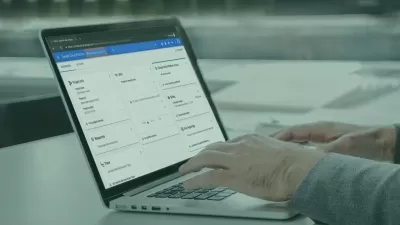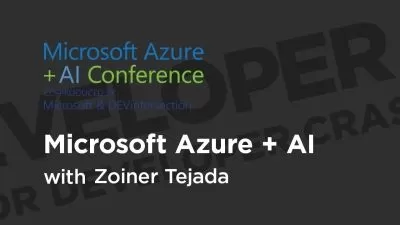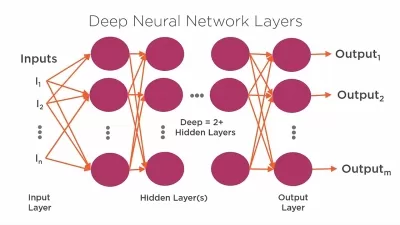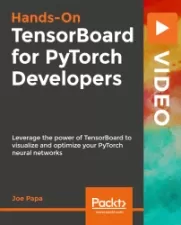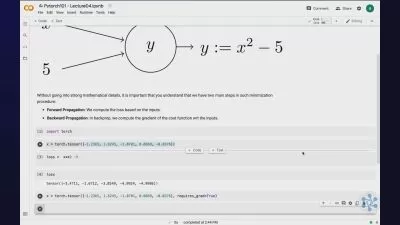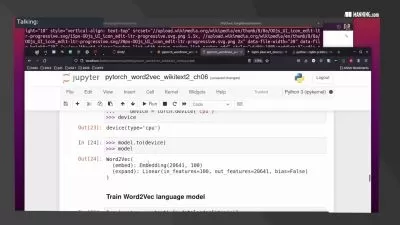Deep Learning with PyTorch
Focused View
15:32:48
80 View
00001 Part 1. Core PyTorch.mp4
01:30
00002 Chapter 1. Introducing deep learning and the PyTorch Library.mp4
12:39
00003 Chapter 1. Why PyTorch.mp4
07:50
00004 Chapter 1. An overview of how PyTorch supports deep learning projects.mp4
09:40
00005 Chapter 1. Hardware and software requirements.mp4
09:50
00006 Chapter 2. Pretrained networks.mp4
08:02
00007 Chapter 2. Obtaining a pretrained network for image recognition.mp4
07:03
00008 Chapter 2. Ready set almost run.mp4
08:24
00009 Chapter 2. A pretrained model that fakes it until it makes it.mp4
07:13
00010 Chapter 2. A network that turns horses into zebras.mp4
06:26
00011 Chapter 2. A pretrained network that describes scenes.mp4
13:09
00012 Chapter 3. It starts with a tensor.mp4
11:35
00013 Chapter 3. Indexing tensors.mp4
11:59
00014 Chapter 3. The tensor API.mp4
07:06
00015 Chapter 3. Tensor metadata - Size offset and stride.mp4
11:30
00016 Chapter 3. NumPy interoperability.mp4
11:14
00017 Chapter 4. Real-world data representation using tensors.mp4
11:56
00018 Chapter 4. 3D images - Volumetric data.mp4
10:57
00019 Chapter 4. Representing scores.mp4
10:09
00020 Chapter 4. Working with time series.mp4
09:07
00021 Chapter 4. Ready for training.mp4
11:35
00022 Chapter 4. One-hot encoding whole words.mp4
09:19
00023 Chapter 4. Text embeddings as a blueprint.mp4
05:55
00024 Chapter 5. The mechanics of learning.mp4
10:28
00025 Chapter 5. Gathering some data.mp4
10:22
00026 Chapter 5. Down along the gradient.mp4
09:10
00027 Chapter 5. Normalizing inputs.mp4
12:43
00028 Chapter 5. Optimizers a la carte.mp4
09:24
00029 Chapter 5. Generalizing to the validation set.mp4
13:42
00030 Chapter 6. Using a neural network to fit the data.mp4
12:27
00031 Chapter 6. More activation functions.mp4
10:37
00032 Chapter 6. The PyTorch nn module.mp4
10:05
00033 Chapter 6. Finally a neural network.mp4
08:50
00034 Chapter 7. Telling birds from airplanes - Learning from images.mp4
11:23
00035 Chapter 7. Distinguishing birds from airplanes.mp4
07:51
00036 Chapter 7. Representing the output as probabilities.mp4
09:52
00037 Chapter 7. Training the classifier.mp4
09:52
00038 Chapter 7. The limits of going fully connected.mp4
07:08
00039 Chapter 8. Using convolutions to generalize.mp4
08:10
00040 Chapter 8. Convolutions in action.mp4
10:29
00041 Chapter 8. Looking further with depth and pooling.mp4
09:57
00042 Chapter 8. Subclassing nn.Module.mp4
12:37
00043 Chapter 8. Training our convnet.mp4
11:21
00044 Chapter 8. Helping our model to converge and generalize - Regularization.mp4
08:28
00045 Chapter 8. Going deeper to learn more complex structures - Depth.mp4
09:45
00046 Chapter 8. Comparing the designs from this section.mp4
07:02
00047 Part 2. Learning from images in the real world - Early detection of lung cancer.mp4
01:35
00048 Chapter 9. Using PyTorch to fight cancer.mp4
11:15
00049 Chapter 9. What is a CT scan exactly.mp4
07:36
00050 Chapter 9. In more detail we will do the following.mp4
08:39
00051 Chapter 9. Why can t we just throw data at a neural network until it works.mp4
08:24
00052 Chapter 9. What is a nodule.mp4
11:40
00053 Chapter 10. Combining data sources into a unified dataset.mp4
07:47
00054 Chapter 10. Training and validation sets.mp4
06:27
00055 Chapter 10. Loading individual CT scans.mp4
08:01
00056 Chapter 10. Locating a nodule using the patient coordinate system.mp4
09:58
00057 Chapter 10. A straightforward dataset implementation.mp4
06:58
00058 Chapter 10. Constructing our dataset in LunaDataset. init.mp4
08:41
00059 Chapter 11. Training a classification model to detect suspected tumors.mp4
09:17
00060 Chapter 11. Pretraining setup and initialization.mp4
08:10
00061 Chapter 11. Our first-pass neural network design.mp4
07:14
00062 Chapter 11. The full model.mp4
11:35
00063 Chapter 11. Outputting performance metrics.mp4
09:30
00064 Chapter 11. Needed data for training.mp4
07:33
00065 Chapter 11. Running TensorBoard.mp4
09:22
00066 Chapter 11. Why isn t the model learning to detect nodules.mp4
06:48
00067 Chapter 12. Improving training with metrics and augmentation.mp4
07:40
00068 Chapter 12. Graphing the positives and negatives.mp4
10:00
00069 Chapter 12. Our ultimate performance metric - The F1 score.mp4
09:28
00070 Chapter 12. What does an ideal dataset look like.mp4
09:04
00071 Chapter 12. Samplers can reshape datasets.mp4
10:38
00072 Chapter 12. Revisiting the problem of overfitting.mp4
12:11
00073 Chapter 12. Seeing the improvement from data augmentation.mp4
09:56
00074 Chapter 13. Using segmentation to find suspected nodules.mp4
08:45
00075 Chapter 13. Semantic segmentation - Per-pixel classification.mp4
10:44
00076 Chapter 13. Updating the model for segmentation.mp4
07:08
00077 Chapter 13. Updating the dataset for segmentation.mp4
07:13
00078 Chapter 13. Building the ground truth data.mp4
11:56
00079 Chapter 13. Implementing Luna2dSegmentationDataset.mp4
07:47
00080 Chapter 13. Designing our training and validation data.mp4
08:24
00081 Chapter 13. Updating the training script for segmentation.mp4
12:37
00082 Chapter 13. Getting images into TensorBoard.mp4
10:58
00083 Chapter 13. Results.mp4
08:47
00084 Chapter 14. End-to-end nodule analysis and where to go next.mp4
10:00
00085 Chapter 14. Bridging CT segmentation and nodule candidate classification.mp4
07:11
00086 Chapter 14. Did we find a nodule Classification to reduce false positives.mp4
06:52
00087 Chapter 14. Quantitative validation.mp4
12:45
00088 Chapter 14. Reusing preexisting weights - Fine-tuning.mp4
13:06
00089 Chapter 14. What we see when we diagnose.mp4
10:41
00090 Chapter 14. Beyond a single best model - Ensembling.mp4
12:14
00091 Chapter 14. Conclusion.mp4
10:02
00092 Part 3. Deployment.mp4
01:04
00093 Chapter 15. Deploying to production.mp4
10:20
00094 Chapter 15. Request batching.mp4
09:19
00095 Chapter 15. Exporting models.mp4
09:03
00096 Chapter 15. Interacting with the PyTorch JIT.mp4
06:48
00097 Chapter 15. TorchScript.mp4
06:46
00098 Chapter 15. LibTorch - PyTorch in C++.mp4
09:06
00099 Chapter 15. C++ from the start - The C++ API.mp4
06:38
00100 Chapter 15. Going mobile.mp4
06:40
00101 Chapter 15. Improving efficiency - Model design and quantization.mp4
08:36
More details
User Reviews
Rating
average 0
Focused display

Manning Publications
View courses Manning PublicationsManning Publications is an American publisher specializing in content relating to computers. Manning mainly publishes textbooks but also release videos and projects for professionals within the computing world.
- language english
- Training sessions 101
- duration 15:32:48
- Release Date 2023/11/06









![Wolfram Mathematica Masterclass in [2023]: Beginners Guide](https://traininghub.ir/image/course_pic/10290-x225.webp)



